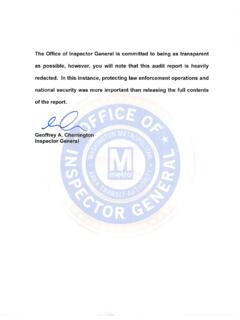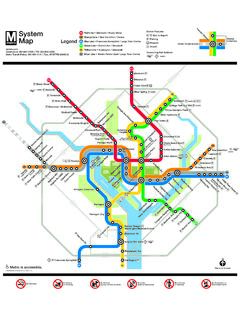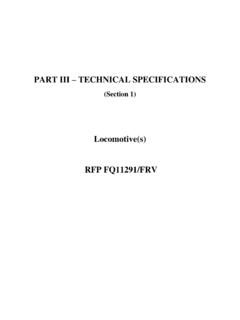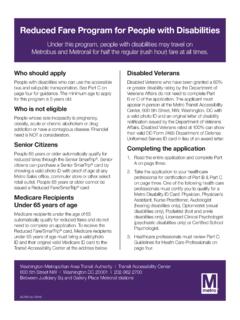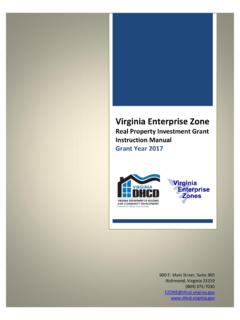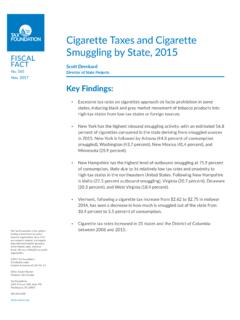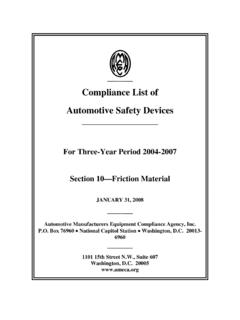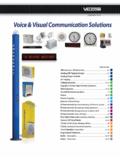Transcription of COMPREHENSIVE ANNUAL FINANCIAL REPORT - WMATA
1 MAINTAINING MOMENTUMWASHINGTON METROPOLITAN AREA TRANSIT AUTHORITYWASHINGTON, DCCOMPREHENSIVE ANNUALFINANCIAL REPORTFOR THE FISCAL YEARS ENDED JUNE 30, 2016 AND 2015 MAINTAINING MOMENTUMWASHINGTON METROPOLITAN AREA TRANSIT AUTHORITYWASHINGTON, DCCOMPREHENSIVE ANNUAL FINANCIAL REPORTFOR THE FISCAL YEARS ENDED JUNE 30, 2016 AND 2015 Dennis Anosike, Chief FINANCIAL Offi cerLa Toya Thomas, ComptrollerPrepared by the Offi ce of Accounting This COMPREHENSIVE ANNUAL FINANCIAL REPORT (CAFR) was prepared by: Office of the Chief FINANCIAL Officer Comptroller, Office of Accounting Washington Metropolitan Area Transit Authority 600 Fifth St., NW Washington, 20001 (202) 962-1602 Dennis Anosike Chief FINANCIAL Officer La Toya Thomas, CPA, CGFM Comptroller Liza Fitzgerald, CPA Assistant Comptroller Taneka Simmons, CPA, CGFM Assistant Comptroller Anthony Pompa Enterprise Solutions Functional Manager CAFR Project Team: Fawzia Hafeez, FCA FINANCIAL Analysis Manager Lori Lloyd-Smith, CGFM FINANCIAL Analyst/Audit Liaison Karen Quarles-Taylor FINANCIAL Analyst Derek Evans FINANCIAL Analyst Julie Barrientos, CPA Audit Readiness Support Marion Buchite, CPA Audit Readiness Support/Audit Liaison Olu Adebo, CPA Audit Readiness Support Table of Contents COMPREHENSIVE ANNUAL FINANCIAL REPORT For the Fiscal Years Ended June 30, 2016 and 2015 Table of Contents Page SECTION ONE INTRODUCTORY (unaudited) Letter of Transmittal.
2 Vii Board of Directors .. xv General Manager s Executive Leadership Team .. xviii Organizational Chart .. xix Certificate of Achievement for Excellence in FINANCIAL Reporting .. xx SECTION TWO FINANCIAL Independent Auditor s REPORT .. 3 Management s Discussion and Analysis (unaudited) .. 5 Basic FINANCIAL Statements: Exhibit 1 Statements of Net Position .. 16 Exhibit 2 Statements of Revenues, Expenses, and Changes in Net Position .. 18 Exhibit 3 Statements of Cash Flows .. 19 Notes to the Basic FINANCIAL Statements .. 21 Required Supplementary Information (unaudited): Exhibit 4 Schedule of Changes in the Net Pension Liability .. 72 Exhibit 5 Schedule of Employer Contributions .. 78 Exhibit 6 Schedule of Funding Progress Postemployment Benefits Other Than Pensions .. 82 Notes to the Required Supplementary Information .. 83 SECTION THREE STATISTICAL (unaudited) FINANCIAL Trends: Exhibit 7 Net Position by Component.
3 90 Exhibit 8 Changes in Net Position .. 92 Revenue Capacity: Exhibit 9 Revenue Base .. 94 Exhibit 10 Passenger Fare 96 Debt Capacity: Exhibit 11 Ratios of Outstanding Debt by Type .. 98 Exhibit 12 Pledged-Revenue Coverage .. 100 Demographic and Economic Information: Exhibit 13 Demographic and Economic Statistics .. 102 Exhibit 14 Major Private 103 Operating Information: Exhibit 15 Authorized Employee Positions .. 104 Exhibit 16 Operating Indicators .. 106 Washington Metropolitan Area Transit Authority iii Table of Contents [This Page Intentionally Left Blank] iv Washington Metropolitan Area Transit Authority SECTION ONE INTRODUCTORY (UNAUDITED)Letter of TransmittalBoard of DirectorsExecutive Leadership TeamOrganizational ChartCertifi cate of Achievement for Excellence in FINANCIAL ReportingPaul S. Sarbanes Transit Center, MarylandIntroductory Section (Unaudited) [This Page Intentionally Left Blank] vi Washington Metropolitan Area Transit Authority Introductory Section (Unaudited) Letter of Transmittal viii Washington Metropolitan Area Transit Authority Profile of the Authority The Authority was created in 1967 by an Interstate Compact (Compact) through legislation passed by the District of Columbia, the State of Maryland, the Commonwealth of Virginia and the United States Congress.
4 The Authority s mission is to plan, build, finance and operate a transportation system in the National Capital area. In fulfillment of this goal, the Authority provides the region with three coordinated types of transportation services: bus (Metrobus), rail (Metrorail) and paratransit (MetroAccess). Construction of the Metrorail system began in December 1969. Later, by February 1973, four area bus companies were acquired forming the basis for the Metrobus system. In May 1994, MetroAccess, the paratransit service for mobility impaired passengers unable to use fixed route transit service, began operation. The original 103-mile Metrorail system was completed with the opening of the miles extension of the Green Line from Anacostia to Branch Avenue on January 13, 2001. In the second quarter of fiscal year 2005, three Metrorail stations and approximately miles of track were added to the Metrorail system resulting in a total of 86 stations, approximately miles of track, and five Metrorail lines (Blue, Green, Orange, Yellow and Red).
5 On July 26, 2014, the Authority opened the first phase of a new Metrorail line (Silver) with five Metrorail stations and approximately miles of track. Metrorail carries the second largest number of passengers and Metrobus carries the sixth largest number of passengers in the nation. The Authority serves a population of approximately million within a 1,500- square mile area. Its transit zone consists of the District of Columbia; the suburban Maryland counties of Montgomery, Prince George s, and portions of Charles and Anne Arundel; Northern Virginia counties of Arlington, Fairfax, Loudoun and Prince William; and the Northern Virginia cities of Alexandria, Falls Church, Fairfax, Manassas and Manassas Park. Organizational Structure The Board of Directors (Board) governs and determines policy for the Authority. The Board is composed of eight voting Directors and eight alternate Directors from each signatory to the compact and from the Federal government.
6 The Directors and Alternates for the Commonwealth of Virginia are appointed by the Northern Virginia Transportation Commission; for the District of Columbia, by the City Council; for the State of Maryland, by the Washington Suburban Transit Commission; and for the Federal Government, by the Administrator of General Services. Subject to policy direction and delegations from the Board, the General Manager/ Chief Executive Officer (GM/CEO) is responsible for the operations and functions of the Authority. The GM/CEO directs staff in implementing and carrying out the programs and initiatives of the Authority. Letter of Transmittal Introductory Section (Unaudited) Washington Metropolitan Area Transit Authority ixBudget The Authority s ANNUAL budget serves as the foundation for its FINANCIAL planning and control. The GM/CEO and staff prepare and submit the budget to the Board for approval.
7 The ANNUAL budget includes both an operating budget and a capital budget. Budget Process The Authority begins planning each ANNUAL budget in August of the previous fiscal year with the development of the General Manager s Business Plan. The budget must be adopted by June 30, and the fiscal year begins on July 1. Budgeting for the fiscal year is divided into seven major phases: business plan development, budget formulation and preparation, budget review, general manager proposed budget, Board of Directors discussion/public outreach and public hearings, budget adoption, and budget implementation/amendment. For fiscal year 2016, the Board approved an ANNUAL budget of approximately $ billion with the largest portion, $ billion, dedicated to operating the system. The budget contained approximately 12,900 authorized staff positions. The budget also includes $ billion for capital improvement programs, $ million for operating reimbursable programs and $ million for capital reimbursable programs.
8 It is the responsibility of each department to administer its operation in such a manner as to ensure that the use of the funds is consistent with the goals and programs authorized by the Board and that approved spending levels are not exceeded. Economic Condition Local Economy The Authority s operations are directly influenced by the economic conditions in the District of Columbia and the surrounding jurisdictions in the State of Maryland and the Commonwealth of Virginia. The regional economy underperformed other metro areas during 2012-2014. This underperformance was primarily the result of the fiscal drag from reduced federal government spending and employment, including the impacts of sequestration; the drawdown of overseas military engagements; and the retirement of older federal employees. That underperformance affected not just transit ridership, but office and commercial vacancy rates, local jurisdictional tax revenues, and overall incomes in the region.
9 However, job growth and overall economic performance in the region improved in 2015 and into 2016. Strengths and weaknesses: The long-term outlook for population growth in both the District of Columbia and the surrounding region as a whole remains positive, particularly as revitalized downtown neighborhoods continue to draw young professionals. The region boasts a highly educated workforce that commands above-average salaries; and employment continues to grow in non-government sectors such as technology, healthcare, and education as the District of Columbia expands as a hub for the east coast of the United States. The region also benefits from a steady supply of tourists to the nation s capital, as well as convention and business visitors. Residential construction has moderated after several years of rapid growth, but the real estate market overall remains strong. The region s Introductory Section (Unaudited) Letter of Transmittal x Washington Metropolitan Area Transit Authority weaknesses include relatively high business and regulatory costs as well as income inequality and a high cost of living, although the primary risk facing the region is the reliance on the federal government.
10 Reliance on federal government: The regional economy remains tightly linked to the federal government, although that reliance is slowly decreasing as federal employment (including government contractors) stagnates or declines compared to other sectors. This reliance on the federal government impacts the Authority in a number of ways: Federal employment: One of the primary reasons for creating the Metrorail system in the 1970s was to provide commuting options for federal employees and contractors, particularly from park-and-ride locations outside of the downtown core. This has remained a primary peak-hour market served by Metrorail, but as those federal employee and contractor jobs have declined, ridership has also been negatively impacted. Federal transit benefit: Given Metrorail s relatively high fares, the monthly transit benefit offered by many employers in the region is important in reducing the out-of-pocket commuting cost.
